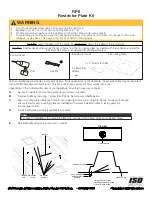
Page 5
DV 38 Gas Fireplace
Installation
Section 1: Installation Overview and Product Dimensions
Figure 1.
Fireplace dimensions, (ALL models, shown on page 3).
Please review the Installation Checklist on page 4 for general
information on preparing for a successful installation of your
fireplace.
The DV 38 fireplace may be installed in any location that
maintains proper clearances to air conditioning ducts, electrical
wiring and plumbing. Safety, as well as efficiency of operation,
should be considered when selecting the fireplace location. Try
to select a location that does not interfere with room traffic, has
adequate ventilation and offers an accessible path for direct
vent installation.
The fireplace dimensions are shown below:
37¾"
11½"
35¾"
5"
8"
29"
5"
8"
21¾"
18¼"
6¼"
5¼"
18"
(Opening)
29½"
1¼"
1"
35¼"
(Opening)
1¼"
1¼"
37¾"
Front View
Side View
Models Included:
L38DFN L38DFL
L38DFNI L38DFLI
Top View
What is Non-combustible?
A given material is said to be non-combustible when it cannot catch fire and burn.
For example, materials made entirely, or in combinations, of, stone, brick, concrete,
tile, steel, plaster or glass are considered non-combustible.
For the purposes of the installations described in this Manual, those materials that
have passed the ASTM E136 tests are considered to be non-combustible.
As of this writing, the materials listed below are reported by their manufacturers to
be non-combustible (in accordance with ASTM E136):
•
James Hardie Building Products, Inc.:
HardieBacker™ 1/4” Cement Board
•
U.S. Architectural Products, Inc.:
Versaroc® Cement Bonded Particle Board
Cem-Clad® Cement Panel
What is Combustible?
Materials that can catch fire and burn are considered combustible. Any material that
is made of, or faced with, wood, wood pulp, paper, plastic or any other material that
can catch fire and burn is considered combustible. Even though these materials may
have been 'flame-proofed', made 'fire-resistant' or are 'fire-rated' they are considered
combustible.
The combustibility of a material can be tested per "ASTM E136 Standard Test Method
for Behavior of Materials in a Vertical Tube Furnace at 750 Degrees C". Note that 'fire-
resistant' does NOT mean non-combustible.
Note: If a certain material has a core considered to be non-combustible (in accordance
with ASTM E136) but is faced with a combustible material then the material is
considered to be combustible.
When in doubt, ask for an ASTM E136 compliance statement.






































